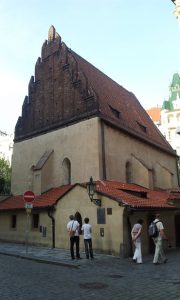The Old-New Synagogue in Prague’s Jewish Town
By Tracy A. Burns
 Franz Kafka attended services here. Legend says that Golem, that artificial being made of clay during the 16th century, is hidden in the attic. Built-in Gothic Cistercian style during the latter part of the 13th century, the Old-New Synagogue is the oldest building in the Jewish Town and one of Europe’s oldest synagogues still in use. It is also the oldest existing medieval synagogue designed with two naves and one of the oldest Gothic structures in Prague.
Franz Kafka attended services here. Legend says that Golem, that artificial being made of clay during the 16th century, is hidden in the attic. Built-in Gothic Cistercian style during the latter part of the 13th century, the Old-New Synagogue is the oldest building in the Jewish Town and one of Europe’s oldest synagogues still in use. It is also the oldest existing medieval synagogue designed with two naves and one of the oldest Gothic structures in Prague.
A witness to historical events
Designed by Christians because Jews were not permitted to build, the Old-New Synagogue has witnessed many pogroms and has served as the center of the Jewish Town throughout past centuries wrought by the suffering and misery of its oppressed inhabitants. Constructed on an elevated site, it dominated the quarter of mostly one-story buildings during the Middle Ages. Imagine its walls streaked with blood: During the pogroms of 1389, some 3,000 Jews met their deaths, many of whom were trying to take refuge in the synagogue. The blood stains remained on the walls until restoration in 1618. The house of worship also survived the very destructive Old Town fire of 1689.
Becoming the center of the Jewish Town
When the Old Town was founded at the beginning of the 13th century, many people moved there. The settlers in the Jewish Town began to gather in the area where the Old-New Synagogue now stands. In the middle of the 13th century, Bohemian King Premysl Otakar II gave Jews the right to protect their synagogues, and the Jews received permission to build a new synagogue. When the sacral building was constructed, it became the center of the Jewish Town, with two markets nearby.
How the Old-New Synagogue got its name
This oblong building with a large saddle roof and late Gothic gables was initially called the New Synagogue because the Old Synagogue was already in existence, on Dusni Street. When new Renaissance synagogues were constructed at the end of the 16th century, the Old-New Synagogue took its current name. According to legend, angels brought the stones of the destroyed Temple of Solomon for its construction on the condition that it would be given back after the temple had been restored. Its Hebrew name, Al tnaj, translates as “on the condition.” Buttresses support the exterior walls. Narrow windows also can be seen from the outside. According to Jewish tradition, the main nave and vestibule are lower than ground level.
Protection from fires
The oldest synagogue in Eastern Europe stands alone, with no adjacent buildings, at the intersection of three streets. The sacral structure was protected from fires because there are no surrounding edifices. One legend says that the wings of angels transformed into doves protect the building from fire. Its original purpose was not only as a place of prayer but also as a public meeting place, school, and office of the high rabbi.
The exterior in Cistercian style
Austere Cistercian style sported only simple ornamentation, so worshippers would focus on the service itself rather than the décor of the building. Nonetheless, the exterior is intriguing. Take a look at the tympanum above the Gothic portal: Its remarkable decoration includes 12 grapevines and 12 bunches of grapes standing for the 12 tribes of Israel. There is a pair of brick Gothic gables from the end of the 14th century, though they have been replaced by a replica from 1883. The low annexes around the building go back to the 14th to 18th centuries. One annex features a women’s gallery, where women could watch services through narrow, horizontal slits in the wall as they were not allowed to participate in the services. The women’s gallery dates from the Baroque period.
The vestibule and the chandeliers in the main nave
The vestibule is also austere, yet its walls seem to speak of the bloodshed and history that the synagogue has witnessed. It is home to two Renaissance strongboxes where tax money used to be collected. Though the synagogue was dimly lit due to its narrow windows in the early days, now there are electric chandeliers that give ample light. Some of the chandeliers hail from the 16th to 19th centuries.
The double-nave design
The double-nave structure features six vaulted bays with five-ribbed vaulting supported by two pillars in the center. The two-nave structure can also be seen at Zlata koruna Monastery in south Bohemia, the Osek Monastery in northern Bohemia, and the Tepla Monastery in western Bohemia. The two-nave design was chosen partially because it made the services more audible and allowed the seats to be arranged against the walls. Five-ribbed vaulting is employed because a groin vault would have produced the sign of a cross. The oldest part of the synagogue is the treasury in the south nave. The place of worship was modeled after a 12th-century Romanesque synagogue in Worms and an early Gothic 13th-century synagogue in Regensburg.
The almemor or bimah
Twelve narrow, lancet Gothic windows are filled with purples, pinks and blues that send the sunrays on the almemor or bimah set on an elevated platform in the middle. The Torah is read here, and sermons and wedding ceremonies take place here. The two octagonal pillars decorated with plant motifs flank the pulpit. The wrought iron Gothic lattice surrounding the almemor dates from the 15th century.
The pews
Nineteenth-century replica wooden seats reserved for high rabbis line the walls. Pay special attention to the seat with the highest back, marked number 1. The Star of David is above it. This was the seat reserved for Jehuda ben Bezalel, called Rabbi Loew, who, according to legend, created the Golem out of clay during the 16th century. The Golem was created to protect Jews during pogroms by employing mystical powers. It is said that anyone who sits there will die.
The Holy Ark
On the walls, there are eight Hebrew inscriptions. On the eastern wall is the Holy Ark, the Gothic shrine for the Torah that is covered by a richly designed drape. Inside the aron ha-kodesh or Torah box is the Pentateuch, written on a scroll. The tympanum boasts a motif of wine leaves similar to the decoration above the Gothic portal entranceway. An upper valance or kapporet partially covers it. The drape and upper valance are decorated with traditional Jewish symbols. Two lions in the form of eagles make appearances. The Torah crown is visible, too. A seven-branched candelabrum also makes up the design. The chandelier in front of the Holy Ark provides “eternal light.” To the right is a stone prayer desk with a shiviti tablet.
The banner
A huge red banner embellished with gold shows the symbol of the Jewish Town with the Star of David in the middle. In the center of the Star of David is a 15th century Jewish hat that Jews were forced to wear whenever they left the ghetto. The words decorating the banner derive from the Shema Yisroel, symbolizing the Jewish faith. The banner hanging from a column was presented to the Jews by Emperor Charles IV in 1357 to celebrate their autonomy. The banner on display now is a 1999 replica based on its appearance when Emperor Charles VI had it restored in 1716.
Restoration
The Old-New Synagogue got a makeover in the late 19th century that replaced much of the original interior. It also underwent renovations from 1921 to 1926. The Nazis planned for the synagogue to be part of their museum dedicated to the extinct Jewish race, so it was not destroyed during World War II. More restoration occurred during 1966-67, and it was fully reconstructed in 1999. Currently, the Rabbi is Karol Efraim Sidon, also a writer and a playwright.



